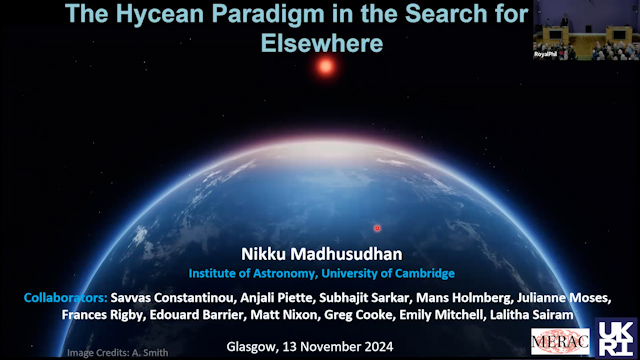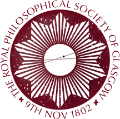The Hycean Paradigm in the Search for Life Elsewhere – Professor Nikku Madhusudhan

A review by member Croy Thomson of Professor Madhusudhan’s talk
“Let me play among the stars, let me see what Spring is like on Jupiter and Mars.” – Frank Sinatra
Tony Burton welcomed and introduced Professor Nikku Madhusudhan, who expressed delight in paying his first visit to Glasgow (he’s worked all over the world and his mind roams the universe, so he plainly has no fear of exploring exotic new territories).
Words worth knowing: 1 – “Hycean”. Derived from Hydrogen + Ocean, two key catalysts for life on Earth; find Hycean planets and we could well find life. 2 – “Exoplanet”. A planet orbiting a star other than our own.
This mind stretcher of an hour was peppered with questions from the Professor: “Are you ready?” he asked more than once of his rapt audience, each time making us pause and wonder, “Ready? Who? Us? For what? What scientific trapdoors is he about to open under us?” I did feel as if I was on the brink of great unknowns, which of course is true: we don’t really know what is Out There. But Professor Madhusudhan showed us that we are readier than we’ve ever been, to find life elsewhere.
We were told of the technological advances that have helped the human race explore deep into the universe. The telescopes Tess, Kepler, Cheops, Plato, Hubble and now the James Webb are enabling astonishing progress in our understanding of what is in and beyond the solar system, and whether there are places that could be habitable by us or where some sort of life may exist.
Using data derived via the telescopes, explained in visuals as beautiful as they are informative, knowledge is gleaned about far-off planets, their properties and whether we’d want to rent one. No, I mean their chemical properties and whether they add up to a life-support system.
Are we prepared to find life as we don’t know it?
Spoiler alert: in a moment that hushed the auditorium to an even hushier hush than was already being hushed, Professor Madhusudhan informed us of a world first: exoplanet K2-18b bears carbon-based molecules. You could have heard an electron drop. Yes, there’s an increasing likelihood we are not alone, and we are every day closer to proving it. Within just one or two decades we may know if we have company.
The questions abounded. “What are robust indicators of life on Hycean worlds?” “Is the James Webb Space Telescope up to the job?” “Are we prepared to find life as we don’t know it?” “When we find life, what do we do next? (Answer: “Find out more!”). We heard of the Transit Method of examining stars, of Transit Spectroscopy, the Habitability Zone, the Trappist-1 System, Atmosphere-Interior Boundary, the Hycean Mass-Radius Plane, Dark Hycean and Cold Hycean … “Are you still with me?” asked the Professor. “Yes!” we replied, some of us more assuredly than others. But what a journey it was, driven by Professor Madhusudhan’s engaging enthusiasm.
Lord Kelvin said: “The life and soul of science is its practical application.” I don’t know what the immediate practical benefits are of sifting the universe for planets that none of us will ever visit, but I do know that curiosity is a defining human trait and who wouldn’t want to play among the stars? In other words, talks like this one inspire belief in the incorrigibly inventive best of humanity.
Professor Pat Monaghan thanked Professor Madhusudhan and presented him with not only the prized Society paperweight, but also the Graham Medal: this was the Thomas Graham Lecture, named after the ground-breaking, 19th century Glasgow University graduate in chemistry.

